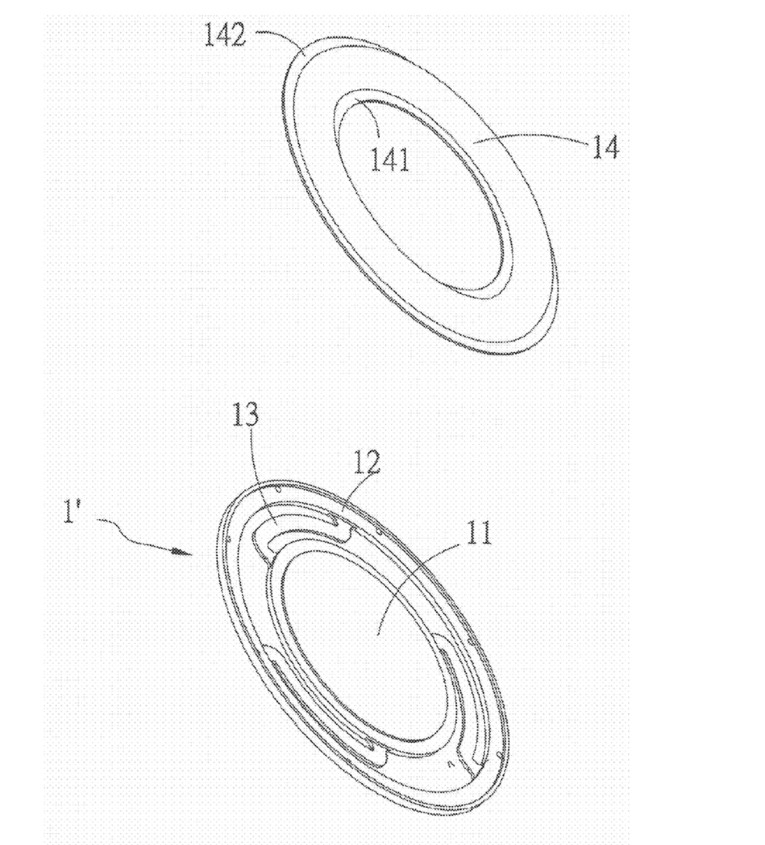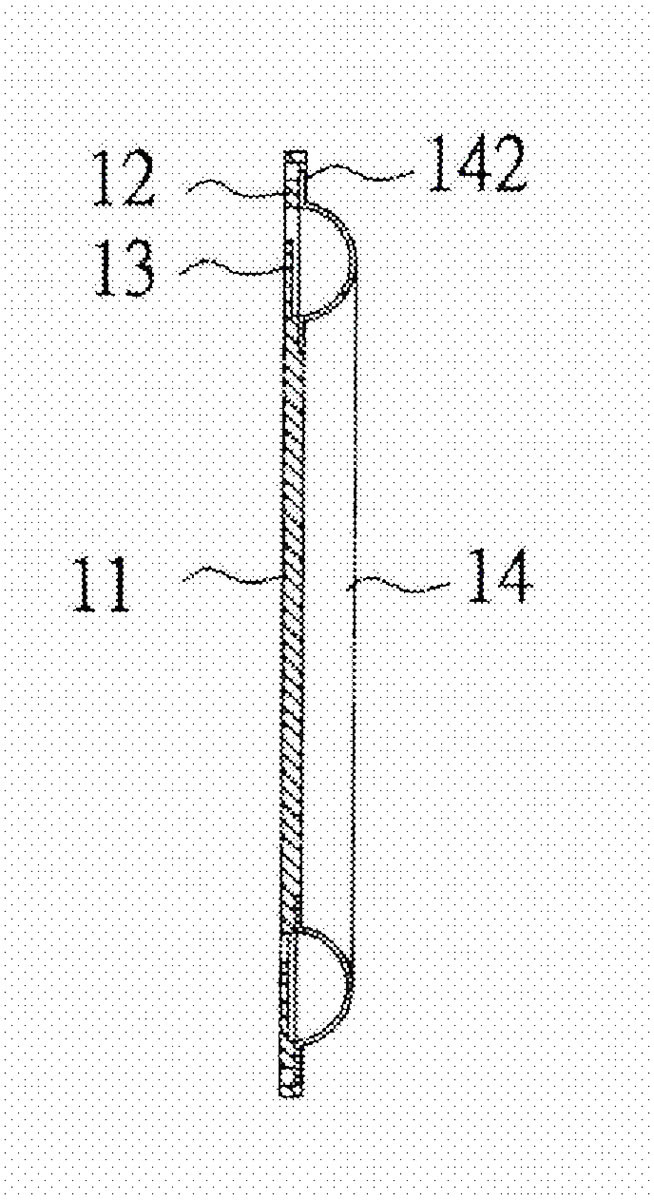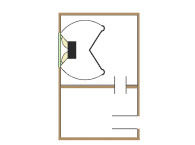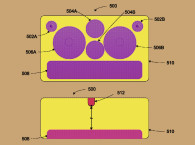
Passive Radiator Structure
Patent Number: US20170085980A1
Inventors: Yeh-Feng Chou; (Tao Yuan City, Taiwan)
Assignee: Meiloon Industrial Co., Ltd.(Tao Yuan City, Taiwan)
Filed: September 22, 2015
Published: March 23, 2017
Granted: April 18, 2017
Number of Claims: 7
Number of Drawings: 4
Abstract from Patent
A passive radiator structure includes an integrally formed diaphragm structure and a surround suspension. The diaphragm structure includes a diaphragm, a frame, and a web-like spider having a plurality of suspension arms integrally extended to between the diaphragm and the frame. The surround suspension has a radially inner gluing edge adhered to a radially inner location of the diaphragm structure around the diaphragm, and a radially outer gluing edge adhered to a radially outer location of the diaphragm structure around the frame. The surround suspension and the web-like spider of the diaphragm structure form two suspension elements for stably supporting the diaphragm, enabling minimized irregular shaking and reduced weight of the diaphragm, as well as reduced sound distortion, increased compliance and upgraded efficiency of the passive radiator structure.
Independent Claims
1. A passive radiator structure, comprising: a diaphragm; a frame externally located around the diaphragm; a web-like spider having a plurality of suspension arms extending between the diaphragm and the frame and circumferentially equally spaced from one another by a predetermined distance and connecting the frame to the diaphragm, such that a single, integral diaphragm structure is integrally formed of the web-like spider, the diaphragm and the frame; and a surround suspension glued over the single, integral diaphragm structure; whereby the diaphragm is supported by both of the web-like spider and the surround suspension.
Reviewer Comments
With the current interest in the development of miniaturized loudspeaker systems, the bass reflex approach is most often utilized due to its ability to realize greater low-frequency acoustic output while reducing the required cubic volume displacement (mechanical excursion times diaphragm surface area) of the active driver(s).
Unfortunately, in applying the bass reflex system to small systems, as one reduces the enclosure volume (acoustic compliance) one must increase the acoustic mass of a bass reflex vent to maintain a given bass tuning frequency. One can increase acoustic mass in a vent by increasing length or reducing the cross-sectional area. If the cross-sectional area is decreased too much then vent losses and audible effects from turbulence become problematic. The more the cross-sectional area is increased to minimize these issues, the more one must increase the vent length to maintain a desired acoustic mass. Since smaller systems require greater acoustic mass, the cubic volume of the vent can further reduce the cubic volume available in the enclosure, requiring a further increase in the vent’s acoustic mass and size, resulting in a smaller enclosure…a vicious circle.
Therefore, the vent substitute of a passive diaphragm radiator has become the more common form of a passive acoustic radiator used in miniature bass reflex systems. The passive diaphragm radiator, or “passive radiator” as it is more commonly referred to, is not universal because it can also have its drawbacks such as:
- A notch in the low-frequency response near the cutoff frequency FC.
- Unstable rocking of the diaphragm during large excursions and/or large structural depth with spaced suspensions to minimize instability.
The first problem is beyond the scope of this review. But suffice it to say, to offset this problem, a passive radiator would have to have a substantially infinite-compliance suspension with minimal resistive losses.
The second issue is the focus of the invention. Many low-cost passive radiators have just a diaphragm with a singular peripheral surround, which most often results in instability and distortion at anything above small signal levels.
High-quality passive radiators tend to be constructed much like a woofer without a magnet, including a second suspension displaced in a plane some distance forward or back from the diaphragm suspension to abate any rocking or instabilities during large signal excursions. These “higher quality” passive radiators usually incorporate more costly frame structures and can also displace even more of the precious internal volume of a small speaker system.
An additional requirement for any optimal passive acoustic radiator is, ideally, at the tuning frequency, it must be able to linearly displace at least 6 dB more acoustic output than the primary active transducer, so it must have one of both of greater diaphragm surface area or greater excursion capability.
In response to these issues, the patent discloses a low-cost, shallow-profile passive diaphragm radiator with enhanced stability. The present invention provides a passive diaphragm radiator that comprises a structure with the composite formation of a frame, a diaphragm, and a multi-armed spider with the suspension arms extended to between the peripheral frame portion and the diaphragm. A standard roll suspension is attached to the peripheral frame and diaphragm, the roll form curving above and away from the spider suspension’s multiple compliant arms.
The diaphragm, spider-arms, and frame may be formed as a singular component, with the roll surround suspension attached as the only assembly step of a simple two-piece structure (see Figure 5). The multi-arm spider structure looks similar to a 45-rpm record adaptor (a clear reference image for our older readers) as it was adapted effectively in a smaller diameter form as a high power/extended excursion metal spider suspension in the Electro-Voice Force woofer transducers at the end of the last century (see Figure 6). David Graebener also developed very high-performing metal versions of this type of spider for use in high-temperature applications when he and I were creating new types of transducers to survive in the extreme, high-temp, caustic environment of active muffler systems for Ford Motor Co. in the 1980s.


As applied in the patent, the multi-armed spider structure placed behind the roll surround provides a stabilizing suspension that can minimize undesired rocking or side-to-side motions of a simple, shallow, single surround suspension passive radiator of the prior art. A unique potential of this type of multi-arm suspension is to create a structure that has greater lateral stiffness while also exhibiting high compliance in the direction orthogonal to the plane of the device. To realize this desirable combination of stiffness/compliance attributes is not a trivial exercise, particularly when attempting to achieve the significant mechanical compliance requirements of a high-performance passive radiator. (As already mentioned, with infinite compliance as the ideal, any increased stiffness in the direction of excursion will have a negative impact near the system’s cut-off frequency.)
That said, with advanced materials and well-executed engineering the desirable attributes should be attainable, resulting in a clever, low-cost device with good performance and little impact in internal enclosure volume. When properly applied, it is expected to be a very effective passive acoustic radiator for use in miniaturized low frequency systems. VC
This article was originally published in Voice Coil, May 2017.








